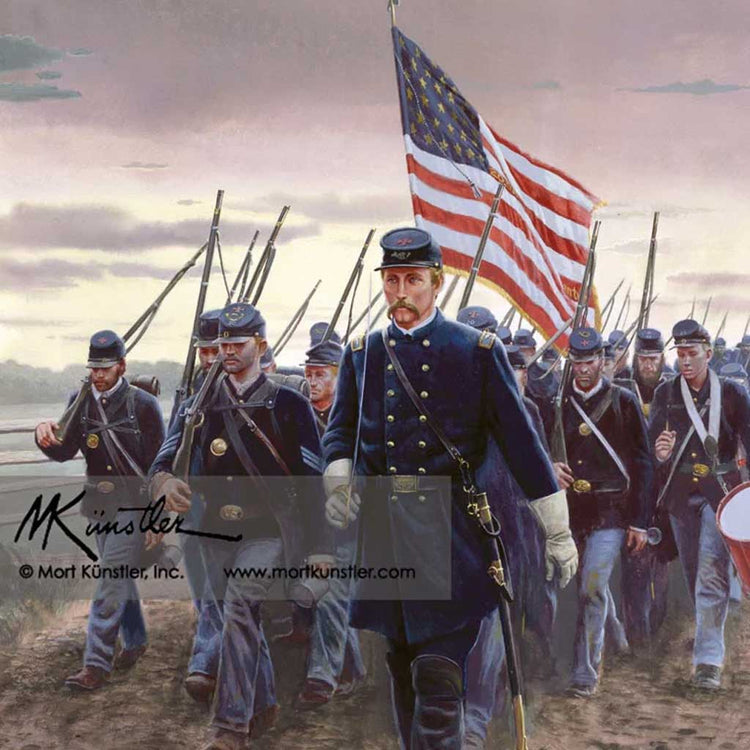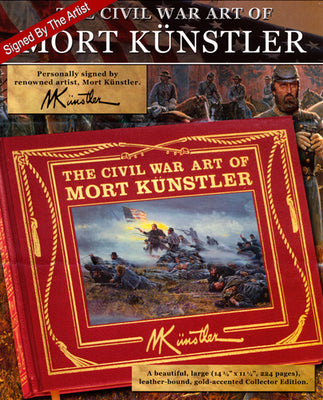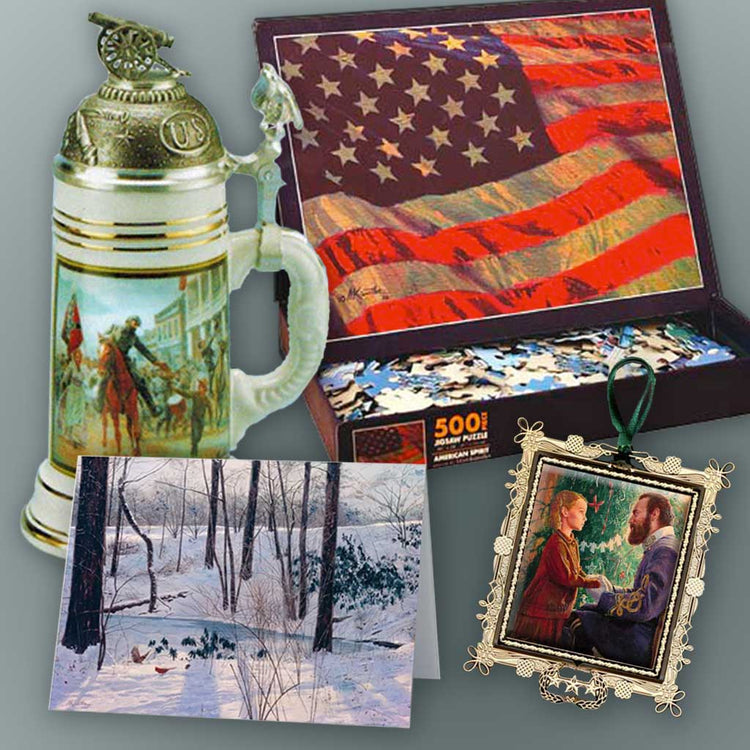About Mort Künstler
Mort Künstler (August 28, 1927 – February 2, 2025) was an American artist known for his narrative and realistic fine art paintings and illustrations. During his prolific career, spanning more than seven decades, he produced paintings of diverse subjects and artistic genres.
Painting since childhood, Mort began his art career in the 1950s as an illustrator, doing work for magazines, books, advertisements and movie posters into the 1960s and 1970s. Through assignments from the National Geographic Society beginning in the 1960s, Mort learned the value of authoritative research in painting historical subjects, which would influence the way he worked for the rest of his career. He became known as “America’s Artist,” chronicling important events in American history and popular culture, from before the Europeans arrived through the Space Age and 21st century military experiences. In 2011 he was commissioned to paint Washington’s Crossing as a more realistic version of Emanuel Leutze’s iconic image. Mort and the painting received widespread critical acclaim for its authenticity and accuracy. His over 300 Civil War paintings, and related books and prints, have earned him recognition among historians and collectors as the foremost painter of the Civil War. Through the masterful use of perspective, light and dark, color and contrast, and meticulous research, his narrative paintings create authenticity and drama.
Mort’s paintings are in the permanent collection of over 50 museums, and have been exhibited in over 60 museum one-man shows. His work has been featured in more than 20 books that have sold over 500,000 copies. Mort lived in Oyster Bay, New York, and retired from painting in 2019.
Early Years and Education
Mort was born on August 28, 1927, in the Coney Island section of Brooklyn, New York. His parents encouraged him from a very young age to draw and paint. His father, Tom, an amateur artist, gave him art supplies and drawing lessons, telling him to draw what he saw, before he even started school. His mother, Rebecca, a teacher, taught him to read before he entered PS 215 Morris H. Weiss Elementary School. When he was in fourth grade, his mother took him to the Brooklyn Museum on Saturday mornings to attend children’s art classes. This exposure to a wide variety of great artists nurtured his love and appreciation of art.
At about eight years old, Mort became confined to his bed due to a series of illnesses. He spent his days drawing. The detailed pencil still lifes he produced of his bedroom, home, family, and neighborhood developed his sense of observation and composition.


Mort’s pencil drawings of his childhood bedroom and his father, Tom Künstler, c. 1936.
While in high school Mort accompanied his father to visit the Manhattan art studio of family friend and commercial artist, Dave Gross, who shared a studio with his artist sons, Arthur and George. They supplied Mort with art materials, gave advice and encouraged and critiqued his work. Mort remembers appreciatively, “Dave, Arthur, and George became positive influences on me because they were the first people I met who were really out there working as artists. As I watched their assignments progress from week to week, I began to understand their business.”
Mort was fortunate to study art at Abraham Lincoln High School in Brooklyn under the guidance of the school’s outstanding art teacher, Leon Friend. A dedicated teacher and the respected author of the classic book Graphic Design (McGraw-Hill, 1936), Friend nurtured the careers of many successful designers, photographers, and graphic artists. Mort remembers, “He was the first person besides my family and the Grosses who really guided me in my art development. He taught me skills in handling materials, gave me an understanding of good design, introduced me to artists and art concepts, and inspired me to be the best I could be. For example, he introduced the Bauhaus School to me and talked about its emphasis on simplified, functional design. He talked about the elements that make an effective poster design (a lesson that helped many of his students win national poster competitions), and he tried to get me away from thinking just in terms of realistic images so that I could understand abstract principles in painting. He was really a remarkable man.”
After Mort’s childhood illnesses which confined him to bed for long periods of time, Mort’s father encouraged him to exercise and play sports. He taught Mort how to swim and dive at Brooklyn’s Manhattan Beach, and provided the equipment for the neighborhood pick-up games. Mort’s athleticism and love of sports would grow and continue throughout his life. He joined the diving and track teams at Abraham Lincoln High School in Brooklyn, and would go on to become Brooklyn College’s first four-sport letterman (diving, basketball, track, and football). After 3 years at Brooklyn College, he transferred to UCLA on a basketball scholarship (only staying one semester before returning to New York after his father suffered a heart attack). During college summers, Mort worked as a waiter and lifeguard at resorts in the Catskills and the Poconos. He and his summer roommate, Bob Cousy (the future Boston Celtics star and NBA Hall of Famer) were recruited by Tamarack Lodge to play on their hotel team against other hotels’ teams also with high level basketball players from New York City; these games provided entertainment for the guests. Mort continued to play basketball at Pratt Institute, where he finished his formal art education. Even as an adult, Mort had regular weekly basketball and tennis games for decades, ran 4 miles after a full day of work in the studio, and split wood when he was well into his 80s.
 Mort chopping wood at age 85.
Mort chopping wood at age 85.
As an art student Mort bicycled through Mexico during the summer of 1949 with a classmate from Pratt Institute to draw and paint the Mexican countryside. He learned Spanish, became adept at watercolor, and painted at least one picture a day, often exchanging the portraits or landscapes for room and board.


Mort on bicycle trip in Mexico, 1949. A watercolor he painted there (Boat on Shore, Veracruz, Mexico, by Mort Künstler, 1949).
Early Work
In the early 1950s, after graduation from Pratt, Mort became an apprentice at Neeley Associates, a busy New York illustration studio. While he made only $30 a week doing every sort of menial job from sweeping to cleaning palettes, he learned the business by watching the illustrators work and asking a lot of questions. After just a few months, Mort left the firm to work as a freelance artist, getting work for paperback book covers and feature stories in the popular men’s adventure magazines. Initially working from the small Brooklyn apartment where he lived with his new bride, Mort would soon share space in George Gross’ White Street studio in lower Manhattan. Gross became his mentor and teacher. They would move their studio to the Lincoln Arcade Building, a commercial building on the Upper West side frequented by aspiring artists. Mort and his artist neighbors at the Lincoln Building would model for each other during those early years.

Mort’s first “job” done in 1951 while he was in art school at Pratt Institute. His art teacher was the art director for the magazine Motor Boating. He instructed Mort to imitate the style of a famous artist who had done previous covers for the magazine.
1951 study of a diesel truck by Mort Künstler while an apprentice at Neeley Associates for company, Autocar.
One of Mort’s first book covers, 1952. Early Western paperback cover by Mort, 1953.
1950s – 1960s
The market for illustrators and illustrations changed significantly during the early years of Mort’s career. Just when he and his contemporaries were getting started, the New York advertising agencies and publishers were increasingly moving towards television rather than print media. This loss of revenue caused magazines to fail or merge, as more illustration work was being replaced by color photography.
However, Mort worked hard and thrived in this competitive environment. By the mid-1950s he had become a skilled working artist receiving jobs from many of the most prominent and popular publishers of the day. Book publisher, Dodd, Mead & Company, and magazines such as The Saturday Evening Post, Classics Illustrated, Sports Afield, Boys’ Life, Outdoor Life, and Magazine Management’s Men’s Adventure, Male, and True Magazine regularly published his work for covers and interior illustrations. They liked his dynamic illustrations, which focused on themes of man’s encounters with nature, criminals and mobsters, damsels in distress, espionage, and military conflicts. They were gripping, rich in detail and immensely popular. Mort completed at least three cover illustrations and two inside illustrations every month, for one publisher, Magazine Management Company, alone. It’s the main reason he used pen names such as Martin Kay and Emmett Kaye: the editors didn’t want it to look like one person was doing all of the magazines’ illustrations.
Mort's first cover for Magazine Management, MALE, April 1954.

In 1969, Mort was asked by author Mario Puzo, who also did work for Magazine Management, to depict the Corleone family for a Literary Guild Bulletin story which would be published as his novel, The Godfather, several years later.
From 1960 to 1963, Mort lived in Cuernavaca, Mexico with his young family. While there he continued to produce work for the men’s adventure magazines, sending his assignments back to New York.
An important part of Mort’s training resulted from his affiliation with National Geographic Magazine. A 1965 assignment to depict the early history of St. Augustine, Florida, introduced Mort to the detailed and comprehensive research needed to render a historically accurate scene. He learned the value of working with historians and subject matter experts which informed his whole approach to historical paintings from that point on.
Building of Castillo de San Marcos, St. Augustine, Florida, and Battle for St. Augustine, 1702, by Mort Künstler, two paintings published in the February, 1966 issue of National Geographic magazine to illustrate an article entitled “St. Augustine, Nation’s Oldest City, Turns 400.”
During this period, Mort also did work for Aurora, Renwal, and other plastic model kit manufacturers. His model box tops featured action pictures of fighter planes, monsters, automobiles and ships.



In 1966, Mort began an important professional relationship with art representatives Frank and Jeff Lavaty that would create new opportunities for him in the decades to come.
1970s
During the 1970s, while still very busy producing covers and inside illustrations for the men’s adventure magazines, Mort began receiving assignments from more mainstream outlets. Magazines such as Newsweek, Good Housekeeping, and MAD, and consumer products advertising agencies demanded his work. Some of these brands were Aqua Velva After Shave, Fleischmann’s Gin, General Electric, International Silver Company, Solarcaine, Texaco, U.S. Trust Co., and Windsor Canadian Whiskey.

Mort’s 1975 artwork, and final ad for Solarcaine.
Major motion picture companies requested Mort’s art for movie posters to promote blockbuster films, including The Poseidon Adventure and The Taking Pelham One, Two, Three. Mort produced art for more than a dozen movies during the 1970s.
Mort's original artwork and movie poster reproduction, The Poseidon Adventure, 1972.
Mort’s paintings began attracting the attention of serious art collectors. Commissions and one-man exhibits kept Mort busy producing new paintings with Western and American History subject matter.
On the recommendation of friend and artist Tom Lovell, Mort was commissioned to paint a series of historical wheat farming paintings by gallery owner, Don Blair. Other friends, the Western artists, Frank McCarthy and James Bama, recommended Mort’s Western paintings to galleries in Texas, Montana, and Arizona.
In 1977, after Mort’s first solo show and major retrospective exhibition at the Daytona Beach Museum of Arts and Sciences, and a one-man show at Hammer Galleries in New York City, he became known as an important painter of historic subjects. Mort would go on to a successful affiliation with Hammer Galleries, having sixteen one-man shows there.
Many of the paintings from this period were reproduced in the first book on Mort’s art, Mort Künstler’s 50 Epic Paintings of America, by noted historian Henry Steele Commager (New York: Abbeville Press, 1979). Many books on Mort’s art would follow, as well as a limited edition print business which began with Frame House Gallery in 1976.
In 1979, Mort became the official Space Shuttle artist for NASA and the Rockwell International Corporation to record the space shuttle Columbia. He was commissioned to document the construction, launch and landing through a series of paintings, which were exhibited at Rockwell sites throughout the country.
Mort Künstler's Rockwell Tile Team, 6 May 1980, and Test Firing the Main Engine, 12 July 1980.
1980s to 2000s
In 1982, a commission from CBS-TV to do a painting for the mini-series The Blue and the Gray steered Mort to concentrate on the Civil War and American history. His meticulously researched paintings became instantly recognized as masterpieces and established him as the country’s most-collected Civil War artist.
The High Water Mark was meticulously researched for historical accuracy. The painting was unveiled at the Gettysburg National Military Park Museum on July 2, 1988 in celebration of the 125th anniversary of the battle.
The popularity of the mini-series and an increased interest in the history of the Civil War, created the opportunity for Mort to establish publishing and licensing businesses based on the growing body of his historical paintings. His historical paintings were exhibited in a number of traveling exhibits across the United States, and published in over 26 books.
2010s to present
In 2010 Mort was commissioned to paint an accurate depiction of Washington crossing the Delaware by then Nassau County Executive Thomas R. Suozzi (later to become NY Congressman, 3rd District 2017-2023).
When first approached … to paint Washington Crossing the Delaware, I was very reluctant to do it. It is a great iconic American image and although it had a number of historical inaccuracies, it was nevertheless very dramatic. Mr. Suozzi convinced me that I could come up with as dramatic as well as an historically accurate painting. Together, we started on a two-month quest to learn the facts. – Mort Künstler

Washington’s Crossing was unveiled at the New-York Historical Society on December 26, 2011 – the 235th anniversary of the actual event. The critically acclaimed and popular painting continues to be exhibited at museums and historical sites. Mort continued to paint images of the Civil War and American Revolution, creating new works for commissions, traveling museum exhibits and books on his art for adults and children, until his retirement from painting in 2019.
Licensing opportunities for his artwork expanded: public and private institutions, including the U.S. House of Congress, Boston Public Gardens, broadcast television and movie production companies, historical museums and other commercial ventures looked for images from Mort's broad portfolio to promote their missions and products.
The global advertising agency Wieden+Kennedy approached Mort in 2012 to create a series of ads based on his men’s adventure style art for the Maximus Vodka brand.
A retrospective of Mort’s work, Mort Künstler: The Art of Adventure, November 8, 2014 through March 8, 2015, was organized by The Norman Rockwell Museum in Stockbridge, Massachusetts. The exhibit included over 80 pieces from early childhood work through his most recent works, and subsequently traveled to museums in New York, Virginia, Texas, and Ohio.
















